Feng Zikai
| Feng Zikai 丰子恺 | |
|---|---|
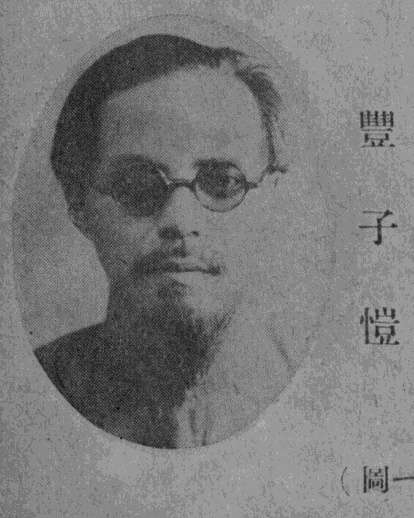 | |
| Born |
November 9, 1898 Shimenwan, Zhejiang (Qing Dynasty China) |
| Died |
September 15, 1975 (aged 77) Shanghai (People's Republic of China) |
| Nationality | Chinese |
| Education | Hangzhou High School |
| Occupation | Artist |
Feng Zikai (simplified Chinese: 丰子恺; traditional Chinese: 豐子愷; pinyin: Fēng Zǐkǎi) (November 9, 1898 – September 15, 1975) was an influential Chinese painter, pioneering manhua (漫画) artist, essayist, and lay Buddhist of twentieth century China. Born just after the First Sino-Japanese War (1894-1895) and passing away just before the end of the Cultural Revolution (1966-1976), he lived through much of the political and socio-economic turmoil that arose during the birth of Modern China. Much of his literary and artistic work comments on and records the relationship between the changing political landscape and the daily lives of ordinary people. Although he is most famous for his paintings depicting children and the multi-volume collection of Buddhist-inspired art, Paintings for the Preservation of Life (护生画集), Feng Zikai was a prolific artist, writer, and intellectual, who made strides in the fields of music, art, literature, philosophy, and translation.
Biography
Early life and education
A native of Shimenwan (石门湾) in Chongde county, Zhejiang Province, Feng Zikai went to school from an early age, the only son and youngest of eight children of a relatively wealthy and educated family. Although the Feng family owned a dye shop, a business made somewhat profitable due to the great number of waterways and trade networks that passed through Shimenwan. Shimenwan lay between Hangzhou and Suzhou, which connected this small rural town to the bigger metropolitans of Beijing and Shanghai. Despite this, Feng Zikai’s father mostly ignored the dye shop, preferring to study endlessly for the civil service exams in Hangzhou that still mostly dictated one’s ability to rise on economic ladder. Ignoring the family business like his father, but also not showing interest in a traditional Confucian education, Feng Zikai’s fascination with art began when he was but a child. Feng Zikai’s father finally passed the provincial exams in 1902, but shortly after that, Feng Zikai’s grandmother passed away, initiating the traditional three-year mourning period for Feng Zikai’s father. During that period however, by 1905, the civil service exams system was abolished. With no path left for him to take the final exams in Beijing, Feng Zikai’s father spent his time drinking, smoking opium, and tutoring his only son. This focus on Feng Zikai, obviously a by-product of being the sole male heir of the family, led to him being a stubborn and strong-willed child. He was doted upon by the townspeople, most likely due to his father’s mild reputation for passing the provincial exams, and was referred to as 'young master' (少爷) by the townspeople. This stubbornness manifested in Zikai’s determination to pursue his own interests, most notably drawing and paintings. Often shirking his lessons with his father, Feng Zikai was captivated by the illustrations and woodblock prints found in his father’s Confucian classics. Feng Zikai frequently stole pigments and dyes from the family stole and colored in many of the illustrations, earning him the scolding and punishment from his father who remained unimpressed with his son's illustrations. Shortly after his father’s death from tuberculosis in 1906, Feng Zikai happened upon a book of figures, and practice tracing and drawing figures, using the book as his guide and reference. He continued to pursue his obsession with tracing figures all throughout elementary school, earning a growing reputation as the “Little Artist”.
In 1914, Feng Zikai travelled to Hangzhou to enroll in the Zhejiang First Normal School (now Hangzhou High School), where his career in art truly took off. The school aspired to manifest the new educational values of the Republic of China, and boasted the highest level funding of any provincial school at the time. Many great artistic and literary figures of twentieth century China were educated here, such as Pan Tianshou, Lu Xun, Ye Shengtao and Xia Miazun. Like many other parents, Feng's mother, recognizing his budding literary talent, encouraged him to attend a school that offered a degree in the humanities in hopes of him becoming a man of letters. This education would prepare to become a teacher and give him a solid training in the Chinese Classics. In line with traditional social expectations and standards, a career pursuing education and literature was preferable to most anything else, but especially one of trade. Furthermore, she wished to see Feng Zikai following in his father’s footsteps, still hoping that the civil service examinations would be reinstated. He entered the school with aspirations to become a teacher, but as fate would have it, the school, led by principal Jing Hengyi (1877 – 1939), emphasized moral and artistic education. The school particularly espoused Neo-Confucian ethics and social duties as well, as they strived to instill within the students a sense of civic duty. Jing Hengyi and his family had been advocates of educational and political reform, and his leadership soon attracted a cohort of talented and devoted students and faculty, including many literary and artistic figures who would become quite renowned. The core philosophy of the school was moral education, encouraging and training students to be the new vanguard of social reformers.
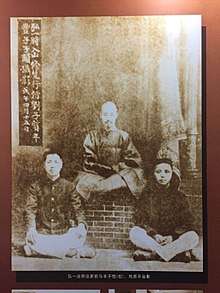
In his third year, Li Shutong, who would later take up the robes and be known as Hong Yi, taught Feng's music and art classes. Hong Yi studied Western painting at the Tokyo School of Fine Art and was infamous for trying to introduce nude painting into the Chinese arts curriculum for the first time. However, more importantly to the development of Feng Zikai's art and person, Li Shutong emphasized sketching, not tracing, when teaching students how to draw and encourage his students to draw inspiration from the French En Plein Air. Furthermore, it was first under Li Shutong's tutelage that Feng Zikai learned the importance of combining moral character (人品) with artistic accomplishment (画品). This would later become a theoretical and methodological foundation for Feng Zikai's own style of painting. Li Shutong, in contrast to Feng Zikai's parents, also encouraged him to pursue his artistic instinct and would later prove to be a profound religious influence on him as well.[1]
Pre-1949 Artistic and Literary Career
After graduating from Hangzhou High School in 1919, Feng Zikai realized that his meager two years of artistic education had him ill-prepared for a life as a professional artist in China. Feng Zikai was also newly married to Xu Limin (1896 - 1983) the daughter of a prominent family from Suzhou, and his mother was now older and sick. The financial responsibilities of being a husband and the sole son now weighed heavily on his mind. Two of her former classmates started an art school, and shortly after graduation, Feng Zikai moved to Shanghai to work as an art teacher. While there, he accepted a part-time position as an instructor at the Chengdong Girl's School as well.[1] Shanghai was a bustling environment, vastly different from the small waterway town that he grew up in. Li Shutong, like many other patriot-intellectuals, such as Cai Yuanpei and Liang Qichao, espoused modern reform values. They believed that a new art articulated by modern educated cultural activists were the key to a revival of Chinese culture and artistic modes of expressions. With the May 4th Movement fresh in student's minds, Feng Zikai brought these values to the classroom through his new role as a teacher. However, Feng Zikai grew more and more despondent, due to a lack of self-confidence in his own abilities to truly teach his students. In light of all the other artists and teachers who have studied abroad, Feng Zikai felt that he could not claim the title of a modern artist. Thus, after scraping some money together, Feng Zikai left for Tokyo in the spring of 1921. By this time, Japan was enjoying the benefits of both the Meiji Restoration and being a victor in World War I and was a haven for Chinese students hoping to receive a modern education. Feng Zikai devoted his time to learning all he could of Japanese and European art, as well as attempting to learn violin, English, Japanese, and Russian. He immersed himself in Kabuki theater performances, old bookstores, research groups, and reading groups. Feng Zikai himself will later cite Takehisa Yumeiji, whose work he first encountered in Tokyo, as a major influential figure in his intellectual development. At the end of ten months, he ran out of money and was forced to return home. However, he returned to China with a renewed faith in the potential of ink paintings.[1]
After Tokyo, Feng Zikai accepted a job at Chunhui High School in Shangyu, a town near Shaoxing. It was during this time that he became part of the White Horse Lake literary group, named after the lake in Shangyu.[2] He was ill at ease in this job, and when political movements clashed, he took it as an out and quit.
Feng Zikai became more and more involved in the burgeoning political movements of his time. His classmates and colleagues invited him to be an essayist and artist for many of the radical magazines and publications that were popping up. Journals such as Aesthetic Education, New Youth, Literature Weekly, and Our July all featured Feng Zikai's early literary and artistic work. Through these publications, Feng Zikai's art started to gain traction in the intellectual circles of Shanghai and his unique style of paintings came to be called manhua. Embroiled in the political and intellectual world of Shanghai, Feng Zikai found his art naturally inclined to reproductive technologies and political periodicals. His art embodied the type of 'Chinese' art that could, at the same time, forward the political wheel of progress of the Shanghai intellectuals.
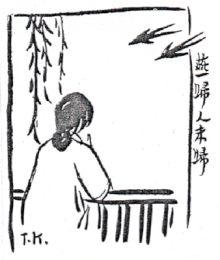
The Kaiming Book Company (开明书店) was a private capitalist venture established in Shanghai in 1926 whose goal was to introduce “new knowledge” to young adults. Feng Zikai taught art and worked as a cover designer and illustrator at the Kaiming Book Company as well as for other publishers. Additionally, the Kaiming Book Company published many of Feng’s art books and essays. The most important journal that the Kaiming Book Company published for young adults was The Juvenile Student (中学生), and as an editor and primary contributor to the journal, Feng Zikai disseminated his art works, his concern for humanitarianism, and his aesthetic thought to many young students through the Kaiming Book Company.[3]
Feng Zikai continued writing, painting, and publishing in various capacities throughout all the changes in the Chinese socio-political landscape. During the Second Sino-Japanese War, Feng Zikai drew many cartoons depicting the horrors of war. However, his artwork stands out as unique, especially compared other artists of his time. He chose to not represent the Japanese antagonists as monsters or inhuman, but rather focus on the objective tragedies of war and the suffering that it wreaks upon the daily lives of ordinary people. Shen Bochen (沈泊尘) was a political cartoonist whose art has been juxtaposed to Feng Zikai's cartoons produced during this time period.[4] Feng Zikai himself was a refugee during the war, having to flee from his home, Yuanyuan Hall, but still, in the face of adversity, he remained committed to his ideals of universal humanism and compassion, as opposed to building nationalism against the Japanese aggressors.[5]
Up until Hong Yi's death in 1942, Feng Zikai kept in close contact with his former teacher and religious mentor. Many of the Buddhist influences found in Feng Zikai's work stem from Hong Yi's impact on Feng Zikai's own spiritual journey. At the time, Feng Zikai was living in Hangzhou and also frequently conversed with Ma Yifu, a prominent Neo-Confucian thinker and scholar.
Post-1949 Career
Feng Zikai's post-1949 has received mixed interpretations, given the unsteady availability of materials on his life. Shelley Drake Hawks attempts to recover Feng Zikai's career after the revolution using materials made available on the public domain, as well as interviews with his children and other close acquaintances.[6] Feng Yiyin, Feng Zikai's daughter, has published biographies and anthologies of her father's artwork and essays, which include previously unpublished works created after 1949 and during the Cultural Revolution. She asserts that Feng Zikai was not 'remolded' despite various re-education attempts, but rather maintained his old beliefs and ideals even though he faced immense social and political pressure to become less 'bourgeois". During this time, Feng Zikai turned to translation as a primary form of intellectual output, and only painted and wrote in secret.[6] In 1954, the Party's art policies shifted and Feng Zikai's pre-1949 cartoons came into the spotlight. Although Wang Zhaowen wrote an article in the People's Daily accusing Feng Zikai's manhua of unhealthy content, Premier Zhou Enlai praised his artwork and commissioned a compilation of his artwork. Zhou Enlai also invited Feng Zikai to write a preface to the anthology, to which the artist was wary of, in case of accidentally overstepping his bounds. Also in 1954, Feng Zikai was invited into the public scene, being granted prominent positions within the art and literary circles. He was offered membership on the Standing Committee of the national Chinese Artists' Association and vice presidency of the regional Shanghai branch.[6] He also helped run various high schools in Shanghai and enjoyed social prominence during the 'Hundred Flowers' period. However, in 1958, Feng Zikai was almost labeled a 'Rightist', but then avoided controversy by laying low. In the 1960s, he was elected to be the president of the Shanghai Chinese Painting Institute as well as the Chairman of the Shanghai Artist's Association. Given his prominent stature and popularity among the public, Feng Zikai found himself continually rising in leadership positions in the Shanghai cultural establishments. However, as time went on, Feng Zikai felt that he could no longer keep silence, writing essays that criticized the Great Leap Forward and other Party policies and initiatives. He believed in the ideology, but felt that the Party did not truly care for the citizens and ordinary people. Feng Zikai's patrons in the upper echelons of the political systems did not feel moved to support him anymore, and Feng Zikai moved into forced retirement. Feng Zikai painted the much of the Paintings for the Preservation of Life post-1949, first collaborating with Hong Yi before his death, and then afterwards, in contact with a Singaporean monk, who helped publish them outside Mainland China.
Death and Legacy
.jpg)
Feng Zikai died on September 9th, 1975, after being diagnosed with lung cancer. His old home, in Shimenwan, has now been converted into the Feng Zikai Memorial Center, where visitors can tour through his old living spaces. Many of his old personal belongings and photos are on display in the permanent exhibition there. Although many of his original artworks were burned throughout the various wars during his lifetime, the most destroyed during the Second Sino-Japanese War, as he was forced to flee his home, many of the major museums around China have his artwork in their permanent collections. The Zhejiang Provincial Museum has the whole of the Paintings for the Preservation of Life are in their archives. Furthermore, Professor Chen Xing has founded and is now currently running a Master Hong Yi and Feng Zikai Research Center at the Hangzhou Normal University.
Fo Guang Shan Monastery has converted Feng Zikai's Paintings for the Preservation of Life into religious murals that decorate the walkways up to their museum. Furthermore, since 2013, the Chinese government has started to use Feng Zikai's paintings as propaganda posters for their China Dream (中国梦) campaign.
The Feng Zikai Chinese Children's Picture Book Award, launched in 2009 to promote Chinese children's picture books, is named in honor of the artist
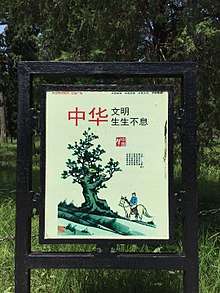
Philosophical Contributions
During his life, Feng Zikai's two main influences religiously and philosophically were Li Shutong (李叔同) and Ma Yifu (马一浮). However, Feng Zikai draws from many different sources, ranging from Chinese and Western art theory to Buddhism and Confucianism, in order to formulate a philosophy of aesthetics as ethics. At the core of this philosophy is the idea of the childlike heart, one that traces back to Mencius (372–289 BC) and was more developed by Li Zhi (1527–1602). Feng Zikai combines this with a similar concept in Buddhism, and asserts that only the one who has the childlike heart can truly see the world for what it is and act rightly. Furthermore, this couples with his fascination with the philosophy behind sketching and the impetus in Chinese paintings that combines the artist's character, emotion, and person into the art to form the idea that children and artists both share the so-called sympathetic heart.
His philosophy finds parallels in Schopenhauer, Nietzsche, and other post-Kantian European philosophers who have also noted the connected between art, play, work, and children. What makes Feng Zikai relatively unique among many of the prominent Chinese intellectuals of his time is his lack in faith in political systems. Throughout his life, Feng Zikai witnessed the fall of the Qing Dynasty, the rise and fall of the Republican China, and the rise of the Chinese Communist Party, as well as European and Japanese imperialism in China. Feng Zikai believed that the failures of the various political systems were symptoms of a greater issue: a lack of common compassion for your fellow human and a sense of morality outside political agendas. Feng Zikai critiqued many social injustices and hypocrisies such as the lack of filial piety, the innumerable numbers of people living in poverty, and the use of Chinese Buddhist ritual for 'transactional karma'. He believed that people did not truly understand the heart of the issue, and encourage us to look to children. One of his most famous paintings juxtapose two children who are holding hands with a man carrying another along in a rickshaw. The title of the painting is: Two Fathers, and hopes to illustrate how social systems impose barriers onto adults that children are not burdened with. In some way, children represent an uncorrupted version of humanity, and (borrowing from Mahayana Buddhism), people must learn to cut the net asunder.
Published works
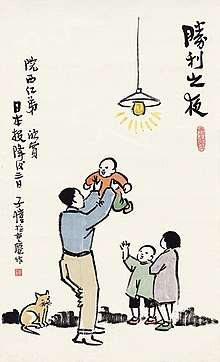
Feng Zikai was a prolific publisher of both paintings, essays, and translations. Many of his famous works include Writings from Yuanyuan Hall (缘缘堂随笔), Paintings for the Preservation for Life (护生画集), A Collection of Feng Zikai Manhua (丰子恺漫画集), a biography of Vincent Van Gogh (梵高生活), and a translation of The Tale of Genji. He was also responsible for illustrating a few of Lu Xun's works, such as The True Story of Ah Q and delivered a series of lectures of Western Classical music, focusing on Russian composers post-Tchaikovsky.
Quotes
In these recent years, my heart has been occupied by four things: deities and stars in the sky, as well as art and children on human earth. My children, who resemble swallows, share the deepest destiny with me, and possess equal standing with deities, stars and art in my heart.
— Feng Zikai, "My Children" (1928)
The real artist must be in complete emotional communion with the object or person depicted, to share their joys and sorrows, their tears and laughter. If you take up the brush but lack this all-embracing sympathetic heart then you will never be a true artist
— Feng Zikai, “Art and Sympathy”
Our land is being overrun by a vicious enemy. It is as though we are in the throes of a disease, and only strong medication can help us fight this illness and survive. The war of resistance is just such a timely treatment. Yet warfare can never be more than a short-term remedy, and we should be wary of becoming addicted to it. As the virus is eliminated and we regain out health, it is essential that we take proper nourishment. And what kind of nourishment is crucial to out long-term well-being? Peace, happiness, and universal love, and the basic ingredient for ‘preserving life’ itself: art.
— Feng Zikai
See also
Further reading
- Chang-Tai Hung, “War and Peace in Feng Zikai's Wartime Cartoons.” Modern China 16, no.1 (1990): 39-83.
- Charles A Laughlin, The Literature of Leisure and Chinese Modernity, (University of Hawaii Press, 2008).
- Christoph Harbsmeier, The Cartoonist Feng Zikai: Social Realism with a Buddhist Face, (Oslo: Universitetsforlaget, 1984).
- Geremie R. Barme, An Artistic Exile: A Life of Feng Zikai (1898-1975), (University of California Press, 2002) ISBN 978-0-520-20832-2
- Marie Laureillard, “Regret of Spring: The Child According to Feng Zikai.” Oriens Extremus 53 (2014): 47-60.
- Shelley Drake Hawks, The Art of Resistance: Painting by the Candlelight in Mao's China, (University of Washington Press, 2017). ISBN 978-0-295-74195-6
- Su-Hsing Lin, “Feng Zikai’s Art and the Kaiming Book Company: Art for the People in Early Twentieth Century China.” Dissertation, Ohio State University, 2003.
External links
- Feng Zikai and his Painting Gallery at China Online Museum
References
- 1 2 3 Geremie., Barmé, (2002). An artistic exile : a life of Feng Zikai (1898-1975). Berkeley: University of California Press. ISBN 0520208323. OCLC 47791167.
- ↑ 1964-, Laughlin, Charles A., (2008). The literature of leisure and Chinese modernity. Honolulu: University of Hawai'i Press. ISBN 9781435666559. OCLC 257560377.
- ↑ Su-Hsing Lin, “Feng Zikai’s Art and the Kaiming Book Company: Art for the People in Early Twentieth Century China.” Dissertation, Ohio State University, 2003.
- ↑ 1949-, Hung, Chang-tai, (1994). War and popular culture : resistance in modern China, 1937-1945. Berkeley: University of California Press. ISBN 0520082362. OCLC 28149757.
- ↑ 1943-, Schoppa, R. Keith, (2011). In a sea of bitterness : refugees during the Sino-Japanese War. Cambridge, Mass.: Harvard University Press. ISBN 9780674062986. OCLC 768122957.
- 1 2 3 Drake,, Hawks, Shelley. The art of resistance : painting by candlelight in Mao's China. Seattle. ISBN 9780295741956. OCLC 981908046.